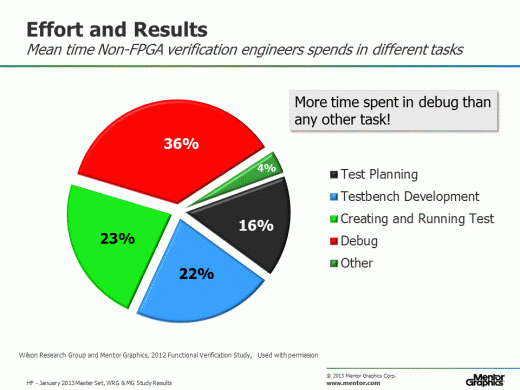New Verification Academy ABV Course
As some of you might be aware, the Verification Academy has a video course dedicated to the topic of Assertion-Based Verification (ABV). In fact, this was the first video course we released for the academy almost six years ago. To date, it has remained one of our most popular courses. Yet one of the most common requests for improvement to this course has been adding content that focuses more on the verification process and provide guidelines on how to effectively integrate ABV into an existing flow. At the Verification Academy, we always welcome your feedback on content improvement. But before I talk about our new, updated ABV course, let me explain to you why I’m such a big believer in this technology.
Ensuring functional correctness continues to pose one of the greatest challenges for today’s SoC design teams. Indeed, recent industry studies have found that more time is spent in functional verification than any other project task. [1] But if you dig a little deeper into the trends revealed by these studies, you will find that debugging is the fastest-growing component of the overall verification process, and that on average, it consumes 34 percent of the verification engineer’s total effort. To make matters worse, the industry is witnessing increasing pressure to shorten the overall development cycle. Clearly, new design and verification techniques that improve productivity—combined with a focus on maturing functional verification process capabilities within an organization—are required.
Assertion-based verification (ABV), although certainly not an end-all to the verification challenge, directly addresses the debugging challenge. For example, those that have effectively adopted an assertion-based verification (ABV) methodology have seen a significant reduction in simulation debugging time (as much as 50 percent [2][3]) due to improved observability. In addition, organizations that have embraced an ABV methodology are able to take advantage of more advanced verification techniques, such as formal property checking, thus improving their overall verification quality and results.
While the process of writing assertions is fairly well understood by those skilled in the art—or whose skill can be easily acquired through a wealth of published papers and books that focus on language syntax and semantics—the process of creating a repeatable ABV methodology that integrates into an existing verification flow is not. And this is where our new ABV course will help. We’ve added a new session titled “Maturing a Project’s ABV Process Capabilities” that provides a set of actionable guidelines and recommendations that are process focused. These recommendations are based on years of ABV experience from multiple projects in various market segments, and they should help you achieve effective adoption of ABV on your project.
To learn more about the new ABV course, visit the Verification Academy (www.verificationacademy.com).
References
[1] Prologue: The 2012 Wilson Research Group Functional Verification Study (here)
[2] Y. Abarbanel, I. Beer, L. Gluhovsky, S. Keidar, Y. Wolfsthal, “FoCs—Automatic Generation of Simulation Checkers from Formal Specifications,” Proc. 12th International Conference Computer Aided Verification, pp. 414-427 (2000)
[3] B. Turumella, M. Sharma, M., “Assertion-based verification of a 32 thread SPARC™ CMT microprocessor,” In Proceedings of the 45th Design Automation Conference, DAC 2008, pp. 256 – 261, (2008)



